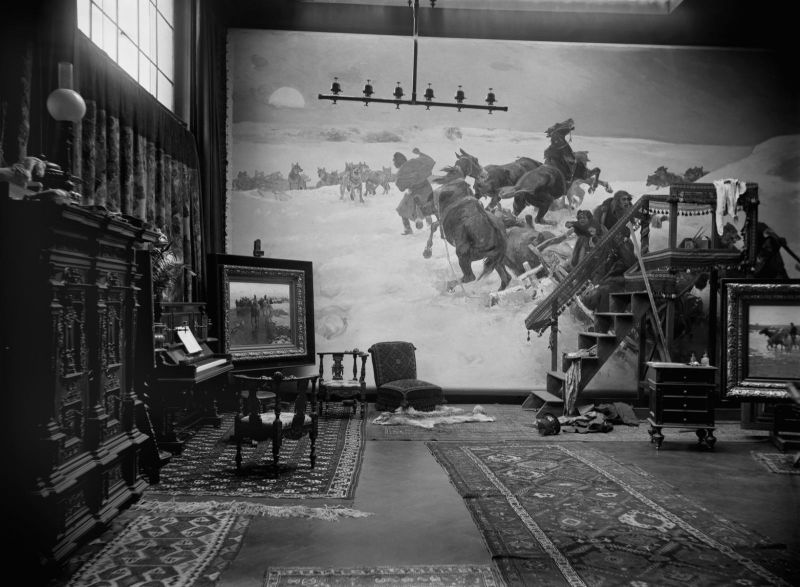Ateliers of Polish painters in Munich ca. 1890
Mediathek Sorted
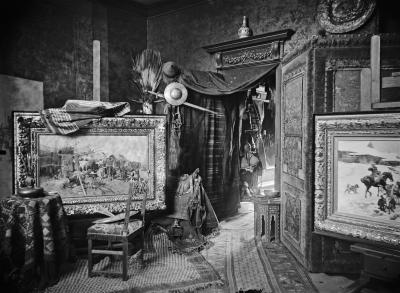
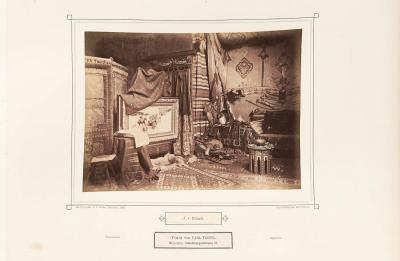

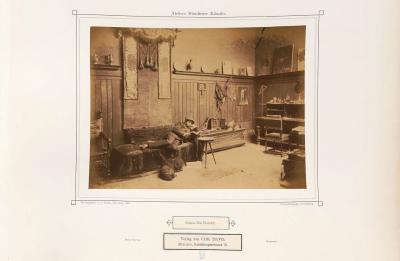






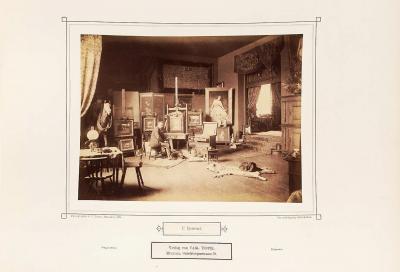




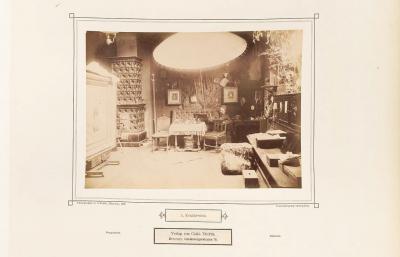


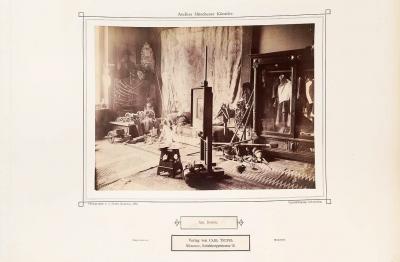



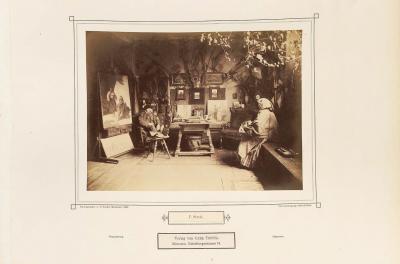

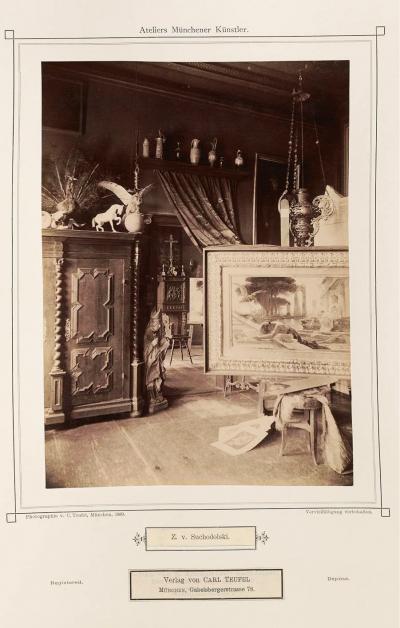

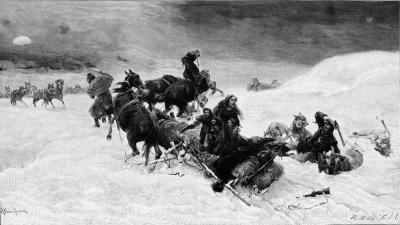


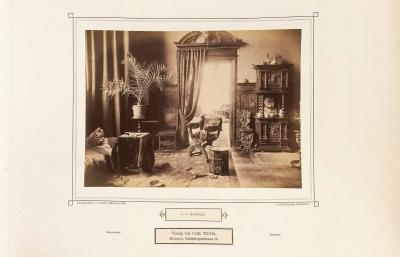
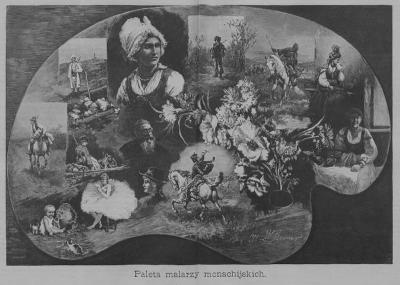


In his atelier, Franciszek or Franz von Ejsmond (1859-1831)[92] also showcased himself as being well established and bourgeois (Fig. 7-9). From 1888 until he left Munich in 1894, he rented his atelier in the atelier building at Theresienstraße 148 in Maxvorstadt on the left of the first floor of the second rear building[93] where he also lived (Fig. 7-9). The work room, where his paintings were lined up and where he was photographed at the easel and leafing through a folder, quietly and without really posing, was high and spacious. The only decorations were created by a few Makart bouquets, coverings, wall hangings and curtains, and, here as well, a Japanese screen. Two breastplates, a stuffed bird, a shelf with vases and bottles give the impression that it was mandatory to have these kinds of requisites as well. There would have been no indication of the type of paintings Ejsmond specialised in or the subjects that were typical for him, had it not been for the life-size wooden horse with bridle and a dummy clothed like a rider which seems to run into the atelier room from the left behind a curtain (Fig. 8). Neither prestigious grandeur nor a museum-like collector’s passion characterise this painter. Steps led to the obviously cosier private rooms that were furnished with carpets, curtains, drapes and small pieces of furniture.
Ejsmond too was of noble descent, the son of a large landowner from near Radom. He initially studied in Warsaw in the private atelier of Wojciech Gerson (1831-1901) and in the Drawing Class/Klasie Rysunkowej under Aleksandr Kamiński (1823-1886) before leaving for Munich in 1879. Until 1886, he studied at the Art Academy under Wagner and under the Hungarian Piloty student and historic painter Gyula Benczúr (1844-1920). He had amicable relationships with Fałat and Brandt. In his paintings, he worked on a wide variety of themes. As well as motifs of people on horseback and snowy hunting scenes based on the model of Brandt and Wierusz-Kowalski, as can be seen on one of the atelier photos (Fig. 7), he also painted figure paintings in the oriental style, portraits, still lifes, flower pieces and religious scenes. He became known, however, for his small-format genre motifs of village and small-town life, which were influenced by Düsseldorf and Munich painters, such as Knaus, Vautier, Harburger and Defregger. His sentimental and humorous scenes idealising domestic bliss and childhood were popular. One such picture, “The Firstborn/Pierworodny”, can be seen in the centre of one of the atelier photographs (Fig. 8) to the right of the large easel and was also distributed as an art postcard by the Munich publishing house owned by Franz Hanfstaengl (Fig. 8a). Versions of this motif can still be found today on the Polish auction market.[94] Next to it on the right, in front of an oven, is a large-format “odalisque” or “gypsy” positioned in the oriental style, which is similar in its stance and headdress to the motif of a painted palette by Ejsmond in the Warsaw National Museum/Muzeum Narodowe w Warszawie (Fig. 8b). Whilst other Munich painters, such as Harburger, constructed entire peasant living rooms as study objects,[95] Ejsmond, after he returned to Poland, purchased a farmhouse with furniture and equipment in Dąbrówka near Grodzisk. The farmhouse served as his atelier and housed his collection of models for his paintings.
When Zdzisław (von) Suchodolski (1835-1908)[96] came to Munich in 1880, he already had most of his artistic career behind him. The son of a military painter, he initially studied law in Krakow and received his first painting lessons from his father before taking up art studies in Düsseldorf. After stays in Brussels and Paris, from 1863 he worked as a freelance painter in Italy, settling on Capri. From 1874 he lived in Weimar, where he married the painter Elisabeth von Bauer, a student of the historic painter Ferdinand Pauwels (1830-1904), and they had a son. After moving to Munich, the family lived on the third floor of Türkenstraße 98 in Maxvorstadt. His atelier was round the corner at Georgenstraße 1, where Suchodolski traded as a historical painter.[97] When the apartment under theirs became free in Türkenstraße, the family moved in and used the apartment on the top floor as their atelier.[98] The photograph of Teufel, which only shows a small section of the atelier rooms (Fig. 18, 19), hints at an upper-class, well established painter. We see a high room decorated with a classical stucco ceiling, baroque furniture, a portrait of his fifteen-year-old son Zygmunt and several ceramic bottles and jugs.
[92] Detailed biography in the Encyclopaedia Polonica, https://www.porta-polonica.de/de/lexikon/ejsmond-franciszek-teodor
[93] Munich address book 1888, Part I, page 70
[94] Franciszek Ejsmond: Ciche szczęście/Quiet happiness, 1887, oil on canvas, 17.5 x 22.8 cm, Auktionshaus Agra Art, Warsaw, 1999, https://sztuka.agraart.pl/licytacja/7/368
[95] Carl Teufel: The genre painter Edmund Harburger in his atelier, photograph, 1889; see Langer 1992, page 37
[96] Detailed biography in the Encyclopaedia Polonica, https://www.porta-polonica.de/de/lexikon/suchodolski-zdzislaw
[97] Munich address book 1885, Part II, page 50
[98] Munich address book 1890, Part I, page 160





















































































